#venetia of the north
Note
Diff anon here! How would u do midsommar!cattonquick?
AIGHT SO
There are multiple configurations, but I would go with:
Felix as Dani.
Eddie as Christian.
Vee and Farleigh filling in for Mark and Josh (we can have a fun doppelganger moment with Farleigh and Simon!)
Oliver as Pelle.
We need to fuck about with the dynamics a bit, because reasons, and we can use Eddie as a lil bit of a dynamic foil for that. Also, I am picturing him as being played by Johnny Flynn.

So; it's the first summer back from Oxford.
Felix and Eddie are in a secret relationship. Eddie, however, is fucking around on Felix with everyone he can, even Venetia, with the excuse of "if I didn’t it would be weird" etc.
Felix finds out about Eddie sleeping with Vee at the start. He's fucking spiralling hard, he could deal with Annabel and India but his sister?
Eddie is more fun than Felix and is having a handjob on a haybale summer with Vee and Farleigh and Oliver. Ollie has kinda wriggled into the group via being in the same tutorial group as Farleigh, and Farleigh is hoping to get him to do some of his essays.
Vee etc don't know why Felix is being so weird. Oliver suggests that they head up North. Take a road trip to his hometown. They do all these weird old pagan things- someone probably makes a Wicker Man joke, Oliver chuckles.
They all head up North. Oliver and Felix are in the same car, and Oliver is very nice to Felix. Felix is trying not to act weird over Eddie, but Oliver seems to know that they're together and is very kind about it.
They head to Prescot, where they meet Paula and Jeff... And then start going somewhere else? Oliver explains that plenty of members of their community go out into the world, but they come back home every summer.
Deep, deep in the British countryside is a plague-era village. You can't get to it easily, you have to go down this hidden and heavily rutted road and it's probably in the Peak District or something so it's really hilly and rural and basically hidden by trees. They follow Paula and Jeff's car there.
They're welcomed by Oliver's big sisters and other members of the village. Oliver explains how it works, casually mentioning that same sex relationships are fine as "there are plenty of children to look after. Two uncles or two aunts isn't a problem. It just means two more people to love the children and help them grow up safe and protected."
Midsommaring commences!
16 notes
·
View notes
Note
Romano! Forgive me, but I am very curious, what was the Risorgimento like?

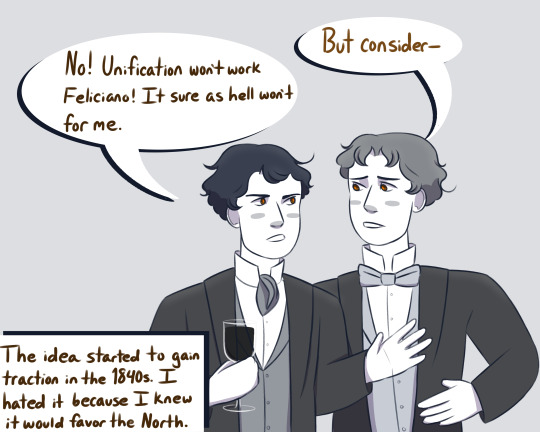


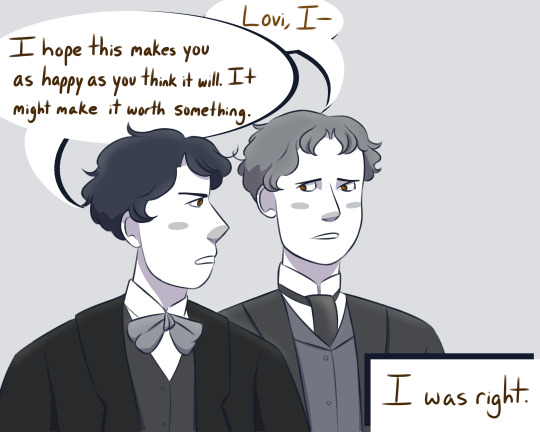
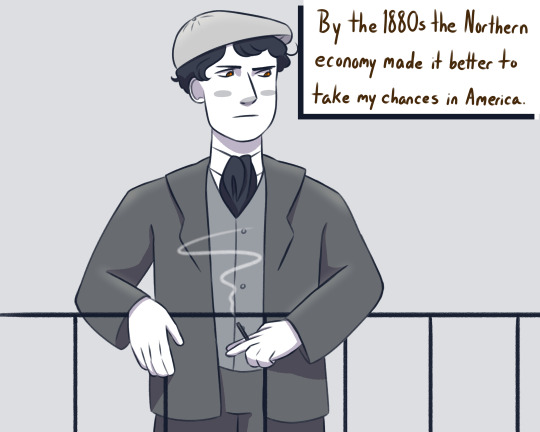
At least in America I don't have a shitload of politicians and bigger empires reminding me of my inadequacies. Just a babe in the woods who's outcompeting my grain sales while I mop his floor.
**Historical Note: In 1816 after the end of the Napoleonic Wars, Southern Italy (Naples and Sicily) became the fully independent Kingdom of the Two Sicilies. It was one of the largest and more powerful Italian states, however, it suffered from unrest throughout the 19th century due to opposition of the conservative Bourbon monarchy and administrative differences between Naples and Sicily. However, despite opposing the monarchy, many Southern Italians were in favor of rewriting the constitution rather than Italian Unification. Even those in favor of Unification were often in favor of strong regional governments within a united Italy rather than a centralized Italian government.
In 1860, revolutionary Giuseppe Garibaldi planned an invasion on behalf of the Piedmontese government. His plan was secretly supported by the British Empire, who had an interest in stunting Sicily's power in the Mediterranean and cheaply acquiring Sicilian sulfur. In March, Garibaldi led an expedition of roughly 1,000 men escorted by British gunboats to invade Sicily. He persisted into Naples and on October 21st, The Kingdom of the Two Sicilies was officially annexed via referendum. When Garibaldi entered Naples, he was largely welcomed by its citizens. King Francis II remained besieged in the fortress of Gaeta until he abdicated in February 1861, at which point the conquest could truly be regarded as complete. It left Venetia and Rome as the only provinces left to be added, as Venetia remained under Austria rule until 1866 and Pope Pius IX rejected the idea of papal territory being absorbed into the rest of Italy.
Although Garibaldi had been welcomed by the majority of the population in Naples, the new government still faced resistance from insurgent groups still loyal to the Bourbons or to the Pope, and later peasants affected by Northern economic policy. Additionally, instead of appointing regional leaders, Southern Italy came to be ruled over by officials from the Piedmont who regarded the South as “barbaric” and needing Northern guidance to become “civilized.” Some even regarded Southerners as not being “truly Italian”, and often propped up these ideas with racist pseudoscience. The government focused its industrialization efforts on the North and saddled the South with unequal tax rates and tariffs.. The South’s agricultural economy struggled to compete, especially with cheaper grain alternatives from countries such as the United States.
The economic situation in Southern Italy after the Risorgimento and general unrest throughout Italy were the largest reasons for the wave of Italian immigrants that arrived in the United States during the late 19th and early 20th century.
#hetalia#historical hetalia#hws romano#hws veneziano#hws italy#aph romano#aph veneziano#aph italy#hetalia ask blog#just wanna say this is very much a sparknotes version of southern italy during the risorgimento#for more risorgimento focused fanworks I highly recommend ask-risorgimento-italy#though focused on veneziano rather than romano it's definitely got a lot more in-depth content about it
102 notes
·
View notes
Text
Saltburn

Hi, I am King, and this is PestoButGay.
Talking of gay, have you seen Saltburn Yet? The homoerotic period piece that lead to a bajillion TikTok’s of men walking around their houses with imitating ART as Sophie Ellis Baxter plays in the background?
Saltburn, transports viewers to the idyllic Saltburn House, where the lives of its residents are set against the backdrop of a picturesque summer sandwiched between uni years at Oxford.
Quite similarly I was asked to my friends summer house in a seaside town of Lyme, equally gay, but a bit less of the whole drinking cummy bath water.
The film follows the eclectic cast, as we follow Oliver, played by Barry Keoghan in awe over Felix, Jacob Elordi, as we are pulled through a scarily British cast ranging from Rosamund Pike to Richard E.Grant and their pets that reside at Saltburn house, from the enigmatic Venetia, to the eccentric Farleigh, or the wine aunt we all have, Pamela. The film, written by Rosamund Pike, as the characters navigate love, loss, and even the passage of time in the quintessentially British setting and class divides we have all become so used to.
What I really love, is the way the house and class is a sort of character in itself in the film. “Saltburn” was this character referred to as if it was heaven, it serves as more than a backdrop for the unfolding drama, it breathes and represents so much more than looks. It feels like its a fully realised character, with its own quirks, history and personality, I even picked on references to minotaurs or paintings like The Garden of Earthly Delights.
"Saltburn" explores the theme of class as another character in the story with the divide between the residents of the estate and the working-class inhabitants of the town to the subtle power dynamics at play within each social dynamic. The film's exploration of class consciousness and the inherent tensions between privilege and poverty adds depth and complexity to its characters and their interactions, shedding light on the broader social landscape of post-war Britain. And I love it even more because 2006 is the perfect setting for this that encapsulates all of those themes, and I think it is so interesting that what for many of us was our childhood can be considered a period piece.
I think I would give it about a 3 and a half stars to be annoying. The half star is purely because we got to see Barry Keoghan naked.
***.
In all honesty, what was that? Man! What a brilliant but also terrible but also stunning and grotesque and stupid and amazing film, yet the film loses me the most at the end. Basically up until he kills Venetia i’m with it! But then it unravels and i understand the thought behind it but at the same time its all dumb!!!!!!!!
I loooved the acting, Rosamund Pike especially but strong performances across the board. Visually stunning, all the things you want in a film, like constantly i found myself grinning at how well shots were put together or the way colours bounced off one another.
The shock value all kinda works for me, where as others looked like they had seen a ghost, I was sat there like it was any other day of the week, It worked for me, the like sexual shock value like the bathtub and the vampire and the grave was all a lotta fun. It just sticks the landing so much to the point it drags down the whole film.
I think the ending would be fine (still bad, but fine) if it didn’t re-contextualise other parts of the film from earlier and give them worse meaning!! he doesn’t need to be this mastermind what the hell is the point in that, let him be a weird little Liverpudlian freak who’s psychosexually obsessed with a 6'6 man and his big ass house like I thought this film was going to be about! Him being from Liverpool had so much potential for further analysis and points to be made to critique North/South class divides and dynamics in place in British society, that were just sort of lost and that was such a shame
i can see my opinion changing, either for the good or the worse tbh, depending on how it sits with me and whether i find myself thinking about the good or the bad more.
3 notes
·
View notes
Text
D.U.D.E Bios: Venetia Winter
Geia's Youngest Step-Daughter Venetia WInter (2020)
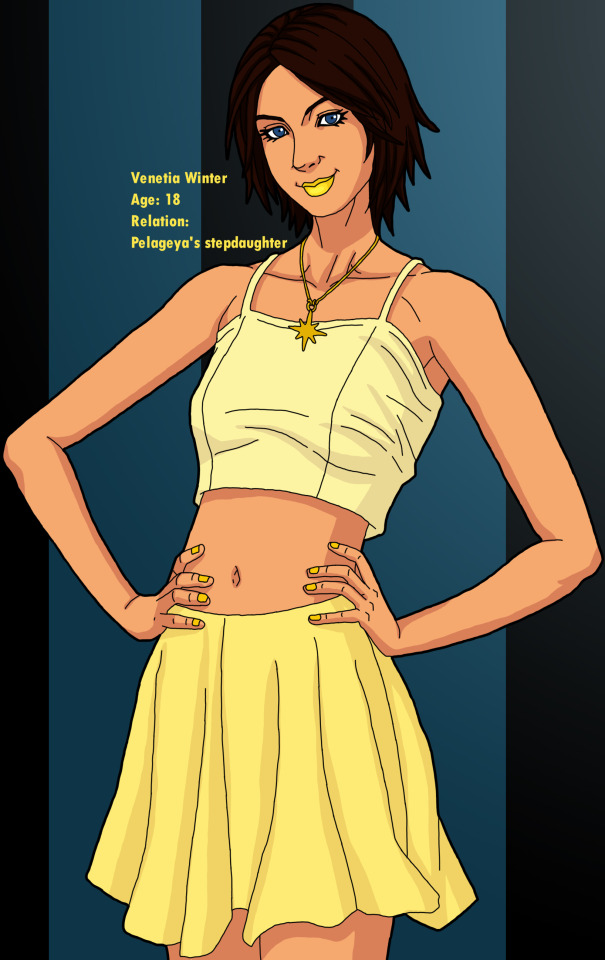
The third daughter of Byron and step-daughter of Pelageya, Venetia. A high-school senior with big dreams of going to an Ivy League school once she graduates.
"Harvard or Yale."
Name
Full Legal Name: Venetia Jessica WInter
First Name: Venetia
Meaning: From the Latin name of the Italian region of Veneto and the city of Venice.
Pronunciation: VEN-ee-tia
Origin: English, Greek
Middle Name: Jessica
Meaning: This name was first used in this form by William Shakespeare in his play 'The Merchant of Venice (1596)', where it belongs to the daughter of Shylock.
Pronunciation: JEHS-i-ka
Origin: English, French, German, Swedish, Norwegian, Danish, Dutch, Italian, Spanish
Surname: Winter
Meaning: From Old English 'Winter’ or Old High German 'Wintar’ meaning 'Winter’.
Pronunciation: WIN-tar
Origin: English, German, Swedish
Alias: None
Reason: N/A
Nicknames: Jess, Jessie, Tia
Characteristics
Age: 18
Gender: Female. She/Her Pronouns
Race: Human
Nationality: American
Ethnicity: White
Birth Date: July 7th 2002
Symbols: None
Sexuality: Sraight
Religion: Christian
Native Language: English
Spoken Languages: English, Spanish, Russian
Relationship Status: Single
Astrological Sign: Cancer
Theme Song (Ringtone on Geia’s Phone): 'Ain't It Fun' - Paramore
Voice Actor: Rachel McAdams
Geographical Characteristics
Birthplace: Spokane, Washington, USA
Current Location: Asheville, North Carolina
Hometown: Asheville, North Carolina
Appearance
Height: 5'5" / 165 cm
Weight: 145 lbs / 65 kg
Eye Colour: Blue
Hair Colour: Brown
Hair Dye: None
Body Hair: N/A
Facial Hair: N/A
Tattoos: (As of Jan 2020) None
Piercings: Ear Lobe (Both)
Scars: None
Health and Fitness
Allergies: None
Alcoholic, Smoker, Drug User: Clean
Illnesses/Disorders: None
Medications: None
Any Specific Diet: None
Relationships
Allies: N/A
Enemies: N/A
Friends: Paulette Nye, Zella Lum, Rosaura Marino, Emperatriz Romero-Marino, Barbara Di Napoli, Saraid Grady-Sullivan
Colleagues: N/A
Rivals: None
Closest Confidant: Pelageya Winter
Mentor: Byron Winter
Significant Other: None
Previous Partners: None of Note
Parents: Byron Winter (53, Father), Caprice Winter (R.I.P, Mother, Née Thorne), Pelageya Winter (33, Step-Mother, Née Volkov)
Parents-In-Law: None
Siblings: Nathan WInter (33, Brother), Zinnia Turner (30, Sister, Née Winter), Xanthia Winter (24, Sister), Joseph Winter (21, Brother), Venetia Winter (18, Sister), Isaiah Winter (15, Brother), Uliana Winter (12, Half-Sister), Emil Winter (9, Half-Brother)
Siblings-In-Law: Genesis Winter (34, Nathan’s Wife, Née Rivers), Patrick Turner (31, Zinnia’s Husband)
Nieces & Nephews: Quincy Winter (13, Nephew), Hadley Winter (10, Niece), Bethany Turner (10, Niece)
Children: None
Children-In-Law: None
Grandkids: None
Great Grandkids: None
Wrestling
Billed From: N/A
Trainer: N/A
Managers: N/A
Wrestlers Managed: N/A
Debut: N/A
Debut Match: N/A
Retired: N/A
Retirement Match: N/A
Wrestling Style: N/A
Stables: N/A
Teams: N/A
Regular Moves: N/A
Finishers: N/A
Refers To Fans As: N/A
Extras
Trivia: Noting of Note
2 notes
·
View notes
Text
WE <3 SLOW FASHION
The fashion industry is one of the most harmful impacts on our environment from child labour, cheap exports and viscous trend cycles. These issues can be connected to the high demand of new designs from consumers that more and more collections are released each year. Around 20 years ago, the fashion industry would only turn out two collections a year, for autumn/winter and summer/spring, but now to keep up with the ever changing trends, release 50-100 mini collections per year (Domingos, Vale &Faria 2022).
In contrast to the harmful impacts of fast fashion, slow fashion has been introduced to mitigate some of these harmful processes. The slow fashion movement represents the need to invest in more durable products and timeless designs in order to transform the values of the fashion industry and adopt more sustainable methods. The movement pushes companies to adopt a business model that prioritises quality over quantity and based on slower manufacturing, ethical attitudes and durable well-made products (Domingos, Vale & Faria 2022). By providing workers with safe and just working conditions, including fair wages, manufacturers can also improve economic aspects of the process (Zhen et al. 2017, p. 83).

The slow fashion movement relates to digital citizenship, with the idea of respecting each other in online spaces and acting responsibility relates to the movement's respect for sweat shop workers and the concept of sustainability. There are a number of influencers that rave about sustainable fashion and educate viewers about things such as finding local brands and how to get involved in fashion and environmental activism. Venetia Le Manna is a "former fast fashion addict turned fair fashion campaigner" who uses her digital platform to call out big companies for over-production and exploitation of their workers. Being a good corporate citizen can be achieved by committing to sustainable fashion, but it can also be extended to being a good digital citizen by acting responsibly online when deciding where your next clothing purchase will be. Once upon a time you were only able to buy second hand clothing if you scoured all your local op shops for hours but nowadays, apps like Depop and Poshmark are available to almost everyone. Facebook Marketplace and Instagram reselling pages are also accessible for branded garments.

I personally buy almost all of my clothes second hand because I love a good bargain. Brands like Princess Polly or Cotton On have ridiculous prices for their basics that I can find at the op shop for half the price. I also don't really like searching through racks of clothing at the op shop because it can get overwhelming so I frequent a women's clothing market in Williamstown that's held every few months. I love that it has a wide range of sellers with different senses of style so I can find a lot of unique pieces for really good prices. Also buying a second hand item holds some sentimental value because I know it's from years or seasons ago, I'll never be able to find it again. I will keep some garments for literally forever if I can. I've had the same Supre black singlet I bought off of a Facebook group for 5+ years and it has not a single hole! And because my favourite clothing market is every few months it’s the only time I'll buy new clothes but sometimes I won't buy anything because nothing catches my eye. However, the last market I went to I found a brand new North Face jacket for $30! The seller just wanted to get rid of it because her daughter didn't want it even after they brought it home from overseas. Similarly, a lot of second hand sellers at markets or on Facebook just want to get rid of clothes that take up space, like the saying "one man's trash is another man's treasure".

References
Domingos, M, Teixeira Vale, V & Faria, S 2022, 'Slow fashion consumer behaviour: a literature review', Sustainability, vol. 14, no. 5
Zhen, L, Henninger, C.E & Alevizou, P.J 2017, 'An Explanation of Consumers' Perceptions Towards Sustainable Fashion - A Qualitative Study in the UK', Sustainability in Fashion A Cradle to Upcycle Approach, Palgrave
0 notes
Photo
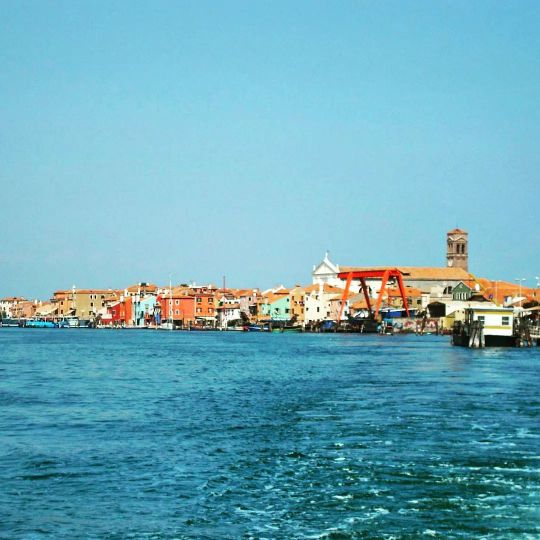
Venice (Veneto). Pellestrina. The lagoon. Having reached the north of the inhabited center along the lagoon, I go back along the seafront, but as mentioned, the lagoon is a few meters away. On the way back, a little on the beach, a little on the walls, I catch a glimpse of a particular building, it is the Venetia domus, an architecturally particular hotel that stands behind Holy Mary of the Miracle, whose bell towers seem to belong to the building. Having reached the port, the village is now recognizable and it is almost easier to grasp its aspects. Shots: a) panorama of Pellestrina as soon as we set sail from the pier; b) glimpse of Pellestrina from the small port, the church of All saints and its bell tower can be seen in the background; c) the Venetia domus; d) the verses composed in Pellestrina, in the square of the Zennari district, on the Murazzi side. #background #side #shots #beach #walls #catch #hotel #santamaria #venezia #venice #pellestrina #veneto #lagoon #seafront #miracle #pier #panorama #verse #travel #traveling #visiting #instatravel #travelling #tourism #instatraveling #travelgram #travelingram #massimopistis #sovVERSIvi #estremisti Information for the purchase of my new book "Extremists!": The book at a cost of 12.00 euros (120 pages), can be ordered in the bookstore (ISBN 978-88-591-5719-9 - Editore Aletti) or requested to the e-mail [email protected] with additional postage (currently 1.28 euros - fold of books). https://www.instagram.com/p/Cplp3jsIpkA/?igshid=NGJjMDIxMWI=
#background#side#shots#beach#walls#catch#hotel#santamaria#venezia#venice#pellestrina#veneto#lagoon#seafront#miracle#pier#panorama#verse#travel#traveling#visiting#instatravel#travelling#tourism#instatraveling#travelgram#travelingram#massimopistis#sovversivi#estremisti
1 note
·
View note
Text



#giethoorn#overijssel#nederland#nederlands landschap#water#canal#lake#lakes#netherlands#dutch#dutch landscape#holland#hollande#mine#my pictures#my picture#photography#amateur photography#venetia of the north#venetie van het noorden#boating#boot#bootje varen#sailing#lakeview#waves#golven#lake waves
7 notes
·
View notes
Photo

The Gazette Times (Pittsburgh); January 25th, 1911.
0 notes
Text
Main Story Masterpost
I decided to make a masterpost for everything one might need to know in order to understand this blog and its story - historical background, characters and crucial plot points. I also added information that was not yet included on this blog but has been discussed on Discord.
Important terminology:
“Risorgimento”
(1) the 19th century movement for Italian political unity
(2) a time of renewal or renaissance, revival
“National representative”/”Representative” - the officially approved personification of a region
“Personification” - a semi-immortal being who embodies a region/culture akin to the idea of a “Leviathan” (Hobbes). Their origins are unknown. They might lead a very public life or prefer to stay anonymous. Usually they're somewhat obscure - most people wouldn't recognize them on the street. Some might believe them to be guardian spirits, pagan Gods, angels sent from Heaven or the spawn of Satan ...depending on who you ask.
“Fusion” - A personification gives up their immortality and allows another representative to “take over” their region.
“Brother”/”Sibling”/”Partner” - personifications usually have multiple overlapping relationship dynamics. None of them are truly related by blood, but some will consider each other to be siblings. Some might consider each other related in the first half of a century and denounce it in the latter or vice versa.
What happened so far...
1798 - The Fall of the Republic
The story of this blog begins after the fall of the Serenissima. The maritime republic has been independent for centuries and is now in the hands of Napoleon. Even though Venice has been struggling to maintain power before, this is considered its death blow. Art is looted or burned and symbols of power destroyed. It is in the very moment Feliciano’s house is vandalized by French troops where he realizes that his life would never be as it was before.
1815 - The Kingdom of Venetia-Lombardo is founded at the Congress of Vienna
Napoleon’s reign is over and Europe is drawing new borders at the famous Congress in the capital of the Habsburg empire. The Veneto is paired with its neighbor Lombardy to form a kingdom that now belongs to the Austrians. Feliciano and Benigno (the representative of Lombardy) have to agree to something akin to an arranged marriage.
1845-47 - The Prelude and the Financial Crisis
Famine, fiscal troubles and the demand for reforms all over Europe turn the continent into a powder keg. Feliciano and Benigno are no longer in a forced partnership. Instead, they are both angry soon-to-be revolutionaries, supporting each other in their struggles.
1848 - The Revolution
Revolutions erupt all over Europe. New governments are formed. Venice becomes the Republic of St. Mark. Lombardy goes through the Five Days of Milan. Feliciano and Benigno often fight in separate places, but are united in spirit.
This is the first time in centuries where Feliciano personally gets his hands dirty in a conflict - he is angry and full of spite. Death to The Austrians is written on the walls with red paint.
1849 - The Fall of the Republic, Act II
After a long siege, starvation and sickness ultimately beat the city of Venice into submission. Feliciano’s fighting spirit is broken and his mental and physical health is at an all-time low. He is forcibly separated from Benigno and does not see him again until 1866.
1848-61 - The Predecessor State
After the failed revolution, the unification takes a much different form.
Tactical warfare and treaties soon replace guerilla warfare. The driving force of this process is the Kingdom of Piedmont. It is sometimes called the predecessor state of Italy. Its personification is a woman called Cassandra. Her goal - to be the sole representative of the peninsula - is considered madness by some and visionary by others.
1861 - The Kingdom of Italy is proclaimed
After almost half a century of political struggles the proclamation of the Kingdom of Italy marks the beginning of a new era. Cassandra, now referred to as Italia by most, offers great benefits to the remaining region's representatives if they “fuse” with her - fusion being an euphemism for a personification giving up their immortality and status as a representative and transferring it to Italia instead.
While many have agreed to the deal, others stay hesitant - namely Benigno (Lombardy), Romano (Naples) and Chiara (Sicily). And then there’s Feliciano, who is still under Austrian occupation...
1866 - The Veneto becomes part of Italy
Venice had somewhat of a special role in the Risorgimento. In 1861, it was not yet part of the Kingdom of Italy. The Habsburg empire has the city and the surrounding region in an iron grip for five more years.
Due to shared goals in their unification process, Italy and Prussia form an alliance against Austria, and the Prusso-German war finally decides over the fate of the Veneto. With Austria losing, Venice becomes Italian territory.
Feliciano as this point is all too happy to hear Cassandra’s offer about “fusion”. He feels tired and weak. Being able to shift the responsibility of nationhood on someone else’s shoulder sounds promising. It would not take long for him to finalize his decision.
1868 - And then things go wrong
Feliciano has decided: he would no longer be the personification of Venice. He says Goodbye to his family and friends, as he would forget his old life and start a new one as an ordinary citizen. Some don’t take these news well. Benigno especially reacts with anger, as he has believed that Feliciano would not agree to Cassandra’s offer. At some point they have a fight that causes Benigno to storm off teary-eyed.
From this point onwards we witness the story from Benigno’s and Romano’s POV.
Benigno is the one to discover Feliciano’s and Cassandra’s corpses. They lie on the floor of Feliciano’s villa in Venice. There is dried blood and flies. No one knows what has happened. The government is shocked to find out about this and tries everything to cover it up. Cassandra’s death could be a fatal blow to the new nation’s political landscape. Her body is preserved with formaldehyde and other heavy chemicals and hidden away in a house somewhere in Turin. Feli is buried in Venice. Benigno is the only one to visit his grave regularly.
He is the sole north Italian representative to survive, and soon takes over Cassandra’s duties. This is where he also clashes with Romano, who is pissed off for not being considered a fitting substitute for the role (the anger is very much justified).
For a whole year, it seems like everything has gone to shit.
1869 - A mali estremi, estremi rimedi
Benigno and Romano are guided to Venice by a mysterious call for help. Neither the caller nor the call is ordinary in nature - it is their (presumably) dead sibling Feliciano somehow infiltrating their thoughts with garbled nonsense. When they finally open the mausoleum, Feliciano is in a bad state. Skin thin as paper, eyes sunken in and comatose - and yet, somehow, with a beating heart. They bring him to his old house where they try to nurse him back to health while they struggle to figure out what this means for Cassandra, themselves, and wherever...or whoever Italy is.
1870 - The Trespasser
Some weeks after the gruesome discovery of Feliciano’s body, Romano and Benigno have yet to figure out how to make Feliciano wake up from his “slumber”. At the same time, a stranger is rummaging through the streets of Venice. The representative of Prussia, Gilbert, is onto something. After some digging (and bribing two police officers) he finally finds what he was searching for - the address to the old abandoned villa where Feliciano has once lived.
When Gilbert decides to break into the place, assuming no one is home, he kicks the door open with a loud bang. Feliciano unexpectedly wakes up in a panicked rush. The situation quickly escalates. There is a bloody fight on a stairwell between Feliciano (who is extremly confused and attacks everyone in sight) and basically everyone else.
Gilbert manages to subdue him, but not before Feliciano has managed to knock out Benigno. As only Romano and Gilbert are left to clean up this mess, they agree to work together and for now ignore the fact that Gilbert tried to break into the house. They would deal with this later. For now, caring for Feliciano and Benigno was their top priority.
And this is where we catch up with the current chapter of the story, where Benigno wakes up and wants to know what the hell Gilbert is doing here in the first place. We will soon find out!
120 notes
·
View notes
Text
Tagged by @robertawickham (thanks!)
Five songs I've been listening to on repeat lately:
Breaking Down (Florence + The Machine), The Rose (Keala Settle), Only Love Can Hurt Like This (Paloma Faith), Book of Love (Mark Vincent), and Miraclass' version of I Dreamed A Dream.
Last movie watched:
I honestly don't remember. I'm a TV person.
Currently watching:
Downton Abbey and GLOW (both rewatches) as well as Marc Maron's daily live instagrams. Keeping up with Bob's Burgers, The Great North, Wellington Paranormal, and Men in Kilts. Sporadically watching episodes of Lupin. Will start Clarice very soon.
Currently reading:
I've been working my way through Georgette Heyer's regency novels to cope with things like the Trump presidency, the pandemic, and parental death. My faves so far are The Nonesuch and Friday's Child. I just finished A Quiet Gentleman and I'm waiting for Venetia to be available at the library.
Tagging: @combeferre @marschallin @baronmpontmercy @sinceremercy @oldbookist
6 notes
·
View notes
Text
Additional Readings for the Eager...and or, those with the Saga-Fever!
As we dig into the wonderfully fantastic saga that is Eyrbyggja Saga, I wanted to give readers the opportunity to look at discussions in Old Norse Scholarship that have buzzed with the themes and topics brought up by this saga! Politics, Gender, Magic, Law, the Restless Undead, Religion-Belief, and the construction of a saga itself! Below this cut you’ll find a regularly updated haphazard Bibliography separated into sections.
Those entries with an * (asterisk) present are free and accessible online–I will be happy to send you a pdf of every other article/chapter if I have it, just DM me the particular article you want at @cousinnick and I will do my best to send it to you. If you have any suggestions to add to the list, I’d be happy to look into them!
Old Norse Read-Along Bibliography: Eyrbyggja Saga
Íslendingasögur/Icelandic Family Sagas:
Andersson Theodore M. The Icelandic Family Saga: An Analytic Reading. Cambridge, Massachusetts: Harvard University Press, 1967.
Andersson Theodore M. The Displacement of the Heroic Ideal in the Family Sagas. Speculum 45, 575—93, 1970.
Byock, Jesse. Medieval Iceland: Society, Sagas, and Power. Berkeley, 1988.
Hastrup, Kirsten. “Defining a Society: The Icelandic Free State Between Two Worlds.” Scandinavian Studies, vol. 56, no. 3, 1984, pp. 235–255.
Jonas Kristjansson. Eddas and Sagas: Iceland’s Medieval literature, trans. Peter Foote. Reykjavik: Hið Íslenska Bókmenntafélag, 1988.
Ian Miller, William. Emotions and the Sagas in Palsson, Gisli 9th ed. From Sagas to Society. Engield Lock: Hisarlik, 1992.
O’Donoghue, Heather. Old Norse-Icelandic Literature: A Short Introduction. Blackwell, 2004.
Vesteinn Olason. Dialogues with the Viking Age trans. Andrew Wawn. Reykjavik: Heimskringla, 1998.
Vesteinn Olason. The Icelandic Saga as a Kind of Literature with Special Reference to its representation of Reality, in Learning and Understanding in the Old Norse World: Essays for MCR, ed. Quinn et al. Brepols, 2007.
Eyrbyggja Saga:
Chadwick, N. K. “Norse Ghosts (A Study in the Draugr and the Haugbúi).” Folklore 57.2 (1946): 50-65.
Kanerva, Kirsi. The Role of the Dead in Medieval Iceland: A Case Study of Eyrbyggja Saga. (2011).*
Sayers, William. “The Alien and the Alienated as Unquiet Dead in the Sagas of the Icelanders.” Monster Theory: Reading Culture. ed. Jeffrey Jerome Cohen. Minnesota: University of Minnesota Press, 1996.
Draugar/Revenants/Restless Undead:
Ármann Jakobsson. “Vampires and Watchmen: Categorizing the Mediaeval Icelandic Undead.” Journal of English and Germanic Philology, 2011, Vol. 110.3., pp. 281-300.*
Ármann Jakobsson. The Troll inside You: Paranormal Activity in the Medieval North. Earth, Milky Way: Punctum Books, 2017.*
Ármann, Jakobsson. “The Fearless Vampire Killers: A Note about the Icelandic Draugr and Demonic Contamination in Grettis Saga.” Folklore, 2009, Vol. 120, no. 3, pp. 307-316.*
Ármann, Jakobsson. “The Taxonomy of the Non-Existent: Some Medieval Icelandic Concepts of the Paranormal.” Fabula, 2013, vol. 54, pp. 199-213. *
Ármann Jakobsson. “The Trollish Acts of Þorgrímr the Witch: The Meanings of Troll and Ergi in Medieval Iceland”. Saga-Book, 2008, Vol. 32, pp. 39-68.*
Chadwick, N. K. “Norse Ghosts (A Study in the Draugr and the Haugbúi).” Folklore 57.2 (1946): 50-65.
Cohen, Jeffrey Jerome. Monster Theory: Reading Culture. Minneapolis: U of Minnesota, 1996. Ebook Central.
Glauser, Jürg. „Supernatural Beings. 2. Draugr and Aptganga.“ In Medieval Scandinavia: An Encyclepedia, Edited Phillip Pulsiano, pg. 623. New York: Garland, 1997.
Hartnell, Jack. Life and Death in the Middle Ages: Medieval Bodies. New York: W.W. Norton & Company Inc, 2018.
Kanerva, Kirsi. The Role of the Dead in Medieval Iceland: A Case Study of Eyrbyggja Saga. 2011.*
Kanerva, Kirsi. “Having No Power to Return? Suicide and Posthumous Restlessness in Medieval Iceland.” Thantos, 2015, Vol. 4, pp. 57-79.*
Kanerva, Kirsi. “Restless Dead or Peaceful Cadavers? Preparations for Death and Afterlife in Medieval Iceland.” Dying Prepared in Medieval and Early Modern Northern Europe. ed. Anu Lahtinen and Mia Korpiola, Leiden: Brill, 2018.*
Kanerva, Kirsi & Koski, Kaarina. “Beings of Many Kinds—Introduction for the Theme Issue ‘Undead’”. Thantos, 2019, Vol. 8, pp. 3-28.*
Laurin, Dan. The Everlasting Dead: Similarities Between The Holy Saint and the Horrifying Draugr. Scandia, 2020. N. 3.*
Merkelbach, Rebecca. Monsters in Society: Alterity, Transgression, and the Use of the Past in Medieval Iceland. Kalamazoo, MI, 2019. The Northern Medieval World.
Sanders, Karin. Bodies in the Bog and the Archaeological Imagination. Chicago, Ill.; London: University of Chicago, 2009.
Sayers, William. “The Alien and the Alienated as Unquiet Dead in the Sagas of the Icelanders.” Monster Theory: Reading Culture. ed. Jeffrey Jerome Cohen. Minnesota: University of Minnesota Press, 1996.
Gender and Sexuality:
Ármann Jakobsson. “Óðin as Mother; the Old Norse Deviant Patriarch.” Arkiv För Nordisk Filologi 126 (2011): 5-16.*
Clover, Carol. “The Politics of Scarcity: Notes on the Sex Ratio in Early Scandinavia.” Scandinavian Studies 60.2 (1988): 147-188.
Clover, Carol J. “Regardless of Sex: Men, Women, and Power in Early Northern Europe.” Speculum 68.2 (1993): 363-87.
Jesch, Judith. Women in the Viking Age. Woodbridge: Boydell P, 1991.
Jochens, Jenny. Old Norse Images of Women. Philadelphia: U Pennsylvania v, 1996.
Jóhanna Katrin Friðriksdóttir, ‘Women’s weapons a re-evaluation of magic in the Islendingasogur.’ Scandinavian Studies 81.4 (2009): pp. 409-28.
Laurin, Dan. But, What About the Men? Male Ritual Practices in the Icelandic Sagas. Kyngervi, 2020.*
Price, Neil. The Archaeology of Seiðr: Circumpolar Traditions in Viking Pre-Christian Religion. Brathair 4 (2), 2004: 109-126.*
Raffield, Ben, Neil Price, and Mark Collard. “Polygyny, Concubinage, and the Social Lives of Women in Viking-Age Scandinavia.” Viking and Medieval Scandinavia 13 (2017): 165-209.
Ström, Folke. Níđ, Ergi and Old Norse Moral Attitudes. London: Published for the College by the Viking Society for Northern Research, 1974. Print. The Dorothea Coke Memorial Lecture in Northern Studies; 1973.
Wallenstein, Frederik, The Burning of Rǫgnvaldr réttilbeini, (Nordic Academic Press, 2013).*
Politics and Law:
Jesse Byock. Feud in the Icelandic Society. (Berkeley 1982).
Firth, Hugh. “Coercion, Vengeance, Feud and Accommodation: Homicide in Medieval Iceland.” Early Medieval Europe 20.2 (2012): 139-75.
Miller Ian. William. Choosing the Avenger: Some Aspects of the Bloodfued in Medieval Iceland and England, Law and History Review 1, 159-204.
Miller Ian. William. Law and Literature in Medieval Iceland. Stanford: Stanford University Press, 1989.
Miller, William Ian. Bloodtaking and Peacemaking: Feud, Law, and Society in Saga Iceland. Chicago, Ill.; London: University of Chicago, 2005.
Fantasy:
Hume, Kathryn. Fantasy and Mimesis : Responses to Reality in Western Literature. London: Methuen, 1984.
Larrington, Carolyne. “The Psychology of Emotion and Study of the Medieval Period.” Early Medieval Europe, 2001, Vol. 10, no. 2, pp. 251-256.
Mundal, Else. The Treatment of the Supernatural and the Fantastic in Different Saga Genres. (2006)
Ross, Margaret. “Realism and the Fantastic in the Old Icelandic Sagas.” Scandinavian Studies 74.4 (2002): 443-54.
Todorov, Tzvetan. The Fantastic: A Structural Approach to a Literary Genre. Cleveland: Press of Case Western Reserve U, 1973. Print. A Volume in the CWRU Press Translations.
Mythology/Vikings:
Clunies Ross, Margaret. Prolonged Echoes : Old Norse Myths in Medieval Northern Society. Odense: Odense UP, 1994. Print. Viking Collection. v. 7, V.10.
Hayward, John. The Penguin Historical Atlas of the Vikings. London: Penguin, 1995.
Jesch, Judith. The Viking Diaspora. New York: Routledge, 2015.
Jones, Gwyn. A History of the Vikings. (OUP: 1968 rev. 1984)
Lindow, John. Norse Mythology: A Guide to the Gods, Heroes, Rituals, and Beliefs. Oxford: Oxford University Press, 2002.
Price, Neil S. The Viking Way : Religion and War in Late Iron Age Scandinavia (2002).
Sawyer, Peter. The Oxford Illustrated History of the Vikings. (OUP, 1997)
Williams, Gareth, Peter Pentz, and Matthias Wemhoff. Vikings : Life and Legend. London, 2014.
Magic in Icelandic Family Sagas:
Ármann Jakobsson. ‘The Trollish Acts of Þorgrímr the Witch: The Meanings of troll and ergi in Medieval Iceland. Saga-Book of the Viking Society 32 (2008): 39-68.*
Davidson, H. R. Ellis. ‘Hostile Magic in the Icelandic Sagas’ in The Witch Figure, rd. Venetia Newall. London: Routledge & Kegan Paul, 1973. 20-41.
Dillmann, Francois-Xavier. Les magiciens dans l'Islande ancienne. Uppsala: Kungl. Gustav Adolfs Akademien for svensk folkkultur, 2006.
Gísli Palsson. “The Name of the Witch: Sagas, Sorcery and Social Context.” Social Approaches to Viking Studies, ed. Ross Samson. Glasgow: Cruithne Press, 1991. 157-68.
Heide, Eldar. Spinning Seiðr. Old Norse Religion in long-Term Perspectives: Orgins, Changes and Interactions. (2006 Lund: Nordic Academic)
Jochens, Jenny. The Prophetess/Sorceress in Old Norse Images of Women. (1996)
Jolly, Karen. Definitions of Magic in Witchcraft an Magic in Europe: The Middle Ages. (2002)
Kieckhefer, Richard. Definitions of Magic in Magic in the Middle Ages. (1989)
Laurin, Dan. But, What About the Men? Male Ritual Practices in the Icelandic Sagas. Kyngervi, 2020.*
Lindow, John. ‘Supernatural Others and Ethnic Others: A Millennium of World View’ Scandinavian Studies 67.1 (1995): 8-31
Meylan, Nicolas. Magic and Discourse of Magic in the Old Norse Sagas of the Apostles in Viking and Medieval Scandinavia. (2011)
Miller, William Ian. ‘Dreams, Prophecy and Sorcery: Blaming the Secret Offender in Medieval Iceland’ Scandinavian Studies 58.2 (1986): 101-23
Mitchell, Stephen. Skirnismal and Nordic Charm Magic. (Turnhout: Brepols 2007)
Mitchell, Stephen. ‘Magic as Acquired Art and the Ethnographic Value of the Sagas’, Old Norse Myths, Literature and Society. Ed. Margaret Clunies Ross. Odense: UP Southern Denmark, 2003. 132-52. (attached).
Mitchell A. Stephen. Witchcraft and Magic in the Nordic Middle Ages. (2011)
Morris, Katherine. Sorceress or Witch? The Image of Gender in Medieval Iceland and Northern Europe. (1991).
Price, Neil. The Archaeology of Seiðr: Circumpolar Traditions in Viking Pre-Christian Religion. Brathair 4 (2), 2004: 109-126.*
Raudvere, Catharina. Trolldomr in Early Medieval Scandinavia’, Witchcraft and Magic in Europe: The Middle Ages. London: Athlone v, 2002. 75-171.
Steven, Justice. Did the Middle Ages Believe in their Miracles? (2008)
Ward, Benedicta. Miracles and the Medieval Mind: Theory, Record and Event 1000—1215. Philadelphia: University of Pennsylvania Press, 1982.
15 notes
·
View notes
Text
Austria-Hungary (1867-1918): Part I, establishing the Dual Monarchy.
It’s gone by many iterations and many names but was ruled by one dynasty, the Hapsburgs. It had been since the Middle Ages: The Archduchy of Austria within the The Holy Roman Empire and later just the Austrian Empire and finally the Austro-Hungarian Empire which expanded to include many other parts of Europe, straddling the expansive crossroads between Central, Southern, Eastern and Western Europe. The focus here will be on its final form which spanned the mid-19th century into the early decades of the 20th century, though a bit of background is needed.
The Hapsburgs were a dynasty of German-Swiss origin that came to power in the Middle Ages and later developed and took over the eventual Archduchy of Austria which combined with their other holdings lead them to become the leading German power and leading power within the loose confederation known as the Holy Roman Empire. Nominally the Holy Roman Empire and its overlord the Holy Roman Emperor was an elective position in which the Emperor was elected by a electoral college of kings, princes & bishops representing various mostly German states and traditionally this could be from any number of dynasties. Effectively from the 15th century onward however, the Hapsburgs would become the fixture on the imperial throne of the Holy Roman Empire.
The early 19th century saw the end of the Holy Roman Empire in 1806 with the defeat of Austria and its allies by the French Empire under Napoleon I of France, who subsequently reformed the German states into the Confederation of the Rhine. This effectively remade the Holy Roman Empire, once a mostly de-facto assembly of Austrian vassals now a collection of French satellite states to buffer against Austria. Preempting the obsoleting of the Holy Roman Empire, it’s last Emperor and Archduke of Austria, Francis II remade himself “Emperor of Austria” in 1804, becoming Francis I of Austria. This ensured that although the title Holy Roman Emperor was obsolete, the Hapsburg family would still maintain an imperial status. It also recognized the truth, that Austria had a sphere of influence and lands subjugated to the Hapsburg monarch that was quite separate from the German Holy Roman Empire and gave increasing attention to and influence these lands It included the Kingdoms of Hungary, Bohemia, Galicia & Lodomeria, Croatia, Slavonia & Dalmatia among various other land holdings. The Austrian Empire in time did contribute to victory over Napoleon and maintained its status of one the great powers in Europe, it made gains in Italy especially, effectively ruling much of the peninsula with the north of the country belonging specifically to the Hapsburgs.
in the decades following the Napoleonic Wars, Europe was under an overall air of conservatism which meant the preservation of peace and balance of power between major European states (Austria, Britain, France, Prussia & Russia) while willing to suppress any liberal or nationalist movements that been inspired by the French Revolution and the eventual developments that lead to the Napoleonic era. However, Austria’s Empire was a multiethnic state all along and the flames of nationalism and liberal reform had been stoked nevertheless culminating in the 1848 revolutions which sprung across Europe. That year, rose to the throne, Franz-Joseph I, who in time would become the living embodiment of imperialism. Franz-Joseph had to contend with several challenges right away, for one he was only 18 when he became Emperor replacing his mentally incapacitated uncle, Ferdinand I. He also had to contend with the ongoing revolutions within the empire, some stoked by nationalist movements, namely in Hungary and Italy. In Italy there was ongoing war with the Kingdom of Piedmont-Sardinia ruled by the House of Savoy which sought to unite all of Italy under their banner. The Piedmontese were supported by Italian nationalists in Lombardy and Venetia which declared republics and fought against the Austrians. However, Franz-Joseph sought to assert a strong and dynamic authoritarian rule over his subjects, a strong believer in the divine right of kings, he sought to present an absolutism over the rebels and the Piedmontese, it worked. The Battle of Novara in 1849 absolutely crushed any hopes of Italian unity at the time, Austria beat the Italians back decisively and peace was restored in the north of Italy. Meanwhile, the Hungarian revolutionaries continued their war and Franz-Joseph was equally determined to suppress their movement too, aided by the Russian Empire and the Tsar Nicholas I, the combined Austrian and Russian forces worked together to brutally defeat the Hungarian rebels in a string of battles that summer, the revolution was put down and Hungary was placed under martial law. With the discontent quieted for the time being Franz-Joseph could rightly state he came to power in a baptism by fire and could now assert his absolutist ideals.
Austria maintained a level of calm over the next decade despite Franz-Joseph being nearly assassinated by a Hungarian nationalist in 1853 but saved in time by a Austro-Irish nobleman. He had capable prime ministers and cabinet members to aid in Austria’s leadership but effectively after 1852 he served as prime minister himself. However, the 1850′s also saw changes in Austria relations with other nations. Russia was at war with the Ottoman, British and Second French Empires in the Crimean War and saw no help offered to it by Austria, seen as a betrayal given Russia’s help to Austria in 1848-49. This lead to a cooling of relations between the two autocratic powers and loss of their alliance. In 1859, renewed Italian nationalism (Second Italian War of Independence) resurged, this time the combined armies of Piedmont-Sardinia & France and supported by smaller Italian states marched against the Austrian Empire in Italy. Austria found itself without aid and was defeated by the French and Italians, forced to cede Lombardy to the French who it turn gave it to the Piedmontese which also annexed Tuscany and other parts of central Italy in exchange for ceding Savoy and the city of Nice to France. This lead to the establishment of the Kingdom of Italy replacing Piedmont-Sardinia in 1861. Though the task remained to unite the rest of Italy, Venetia including Venice and Friuli remained in Austrian hands, Rome belonged to the Papacy and Naples and Sicily were united as the Kingdom of the Two Sicilies. This would remain a source of contention in the coming years.
The other front in which Austria faced trouble was in the German speaking parts of Central Europe. After Napoleon’s defeat, the Holy Roman Empire was not restored but once more the German states were organized into a loose confederation that once again saw Austria as its nominal leader and dominant power at the new German Confederation. However, during the Napoleonic era Germany was divided between support for the French (often coerced) and opposition namely in Austria and the other great power of German peoples, the Kingdom of Prussia. Prussia and Austria had issues going back to the early 18th century under Frederick the Great and fought several wars which saw Prussia’s military, political and cultural reputation thrive at the expense of Austria, nevertheless they learned to coexist in the wake of the French Revolution and Napoleonic Wars. Prussia was ruled by the Protestant Lutheran Hohenzollern dynasty in opposition to the piously Catholic Hapsburgs of Austria. Prussia during the first half of the 19th century sought to expand its power once again with France somewhat removed as a threat. However, Prussia’s expansion didn’t start with Austria, it was actually with Denmark and the German speaking provinces of Schleswig-Holstein which belonged to the Kingdom of Denmark. The Danes actually defeated the Prussians in a war lasting from 1848-1852, maintaining control of these regions. However, in 1862 Prussian nobleman and politician turned Minister-President (Chancellor) Otto Von Bismarck began to take steps to unite Germany under Prussian hegemony by starting a series of wars. His first target was the Danes in a second war in which Prussia teamed with Austria against the Danes and defeated them in 1864. Both Austria and Prussia got joint custody of Schleswig and Holstein from Denmark. Prussia’s military had underwent reforms in the 1850′s and 60′s which showed a much improved military whereas the Austrians had a much more stagnated military, this would prove consequential.
1866 saw tensions over the joint custody of these acquired territories between Prussia and Austria. Both nations mobilized partially for war as a result. Bismarck also made an alliance with the Kingdom of Italy and in the summer of 1866, the Austro-Prussian War/Third Italian War of Independence broke out, it also became known as the Seven Weeks War. The combined fight on two fronts proved too much for Austria and they were defeated decisively in this German “civil war” at the Battle of Konnigratz by the Prussians whose military reforms again proved decisive. The Italians had a much harder time against the Austrians but nevertheless were granted a joint peace with the Prussians as part of Bismarck’s deal to secure their alliance. Austria having beat the Italians refused to hand over Venetia to them directly, instead they offered it to the neutral French, who in turn had a deal with Italy and handed to them anyway, leaving only Italian Tyrol and Friuli and the city of Trieste in Austrian hands. More damaging to Austria then the loss of a major Italian possession was the loss of influence over German states, once and for all. Prussia had supplanted them with the establishment of yet another new confederation, the North German Confederation, from which Austria and some other southern German states, mostly Catholic were excluded. No territory was lost to Prussia despite the desire of some Prussian nationalists. Bismarck however wanted to supplant Austrian influence in German territories not permanently damage relations with Austria altogether, still seeing them as a necessary link in maintaining a balance of power in the future. This strategy would pay off in the forging of an alliance that was to last with dramatic results through World War I in the 20th century. Bismarck would have one last war, the Franco-Prussian War of 1870-71 against which Prussia and host of other German states fought and defeated the Second French Empire and then united as the precursor to the modern German state, the German Empire or Germany. Austria sat that war out, despite some consideration of allying with France. This would tie Austria’s future to Germany and Germany’s future to Austria but more on that in a later post.
In the immediate aftermath of 1866, Austria having been expelled from German affairs as Prussia united the other states into the German Empire, once more turned its focus on itself and its non-German realms. It was in need of a drastic reform or else it would fall. Its weakness was exposed and the state treasury was in debt and a lasting peace was needed otherwise as German and Italian nationalism had shown the Hapsburg dynasty would fall. As a result the Austrians who were ethnically German decided they need to make a new arrangement with their historically other most sizable and powerful component in the imperial jigsaw, Hungary. A new arrangement, called the Austro-Hungarian Compromise of 1867 gave birth, a rebirth to the Hapsburgs, creating the Austro-Hungarian Empire, also known as the Dual Monarchy or Austria-Hungary in common parlance.
The terms of this compromise was essentially as follows: Hungary’s pre-1849 constitution which granted it special privileges' was restored, martial law was ended. Both Austria and Hungary would have their own divisions politically but be united under a common monarch, the Austrian Emperor who was also King of Hungary, the so called Emperor-King Franz-Joseph I. Domestic affairs in Hungary which included a good portion of the overall empire would be handled by the Hungarian parliament in Budapest while the Austrian run territory included another half of the empire and was run by a parliament made up of the various nationalities within the empire, these were from the so called crown-lands under the rulership of the common monarch. Austria and Hungary issued separate passports and had their respective parliaments and prime ministers in Vienna and Budapest respectively. However, their was a common ministry of Foreign Affairs for diplomacy and foreign affairs, additionally the army and navy would be for a common defense and War Ministry for the common defense. Additionally, there was a common currency. Hungary also took on a portion of Austria’s debt. Finally, the Emperor-King was head of state in both halves of the empire. He held supreme and absolute control of the military, could singularly declare war or a state of emergency, could appoint members to the cabinet council which came from the Austrian and Hungarian halves of the empire, could veto any bill of the National Assembly or preempt law with royal assent as well as dissolve the National Assembly as he saw fit.
The result was a newly reformed nation which supposedly balanced the needs of both halves of the empire but in practice saw the two biggest ethnicities (Germans & Hungarians) which formed a plurality rather than a majority of the population, arrange for power-sharing agreement to be in their hands in order to preserve their common monarch’s dynasty and balance ruling ethnicity desires while satisfying some of the nationalist concerns of the second largest nationality within the empire. Though the empire in fact consisted of nearly a dozen distinct ethnic groups each with their own language and nationalist/cultural traditions and aspirations. This would result in a complex interplay of ebbing and flowing tensions under the surface of governance, an undercurrent that would shadow and shape the empire for its entire political existence. Additionally, there would be attempts to create a sort of transcendent supranational Hapsburg identity, mostly embodied in the living person of Emperor Franz-Joseph himself and his treatment of ethnic minorities. Despite the pressures internally and those stoked by external influences, the 1867 compromise was adopted and gave the state a second lease on life in its monarch and government. It would continue to function with this effective arrangement all its days while also considering how to both maintain it and still address another potential reinvention down the line...
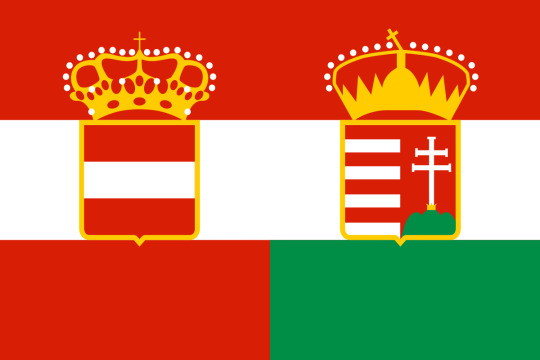

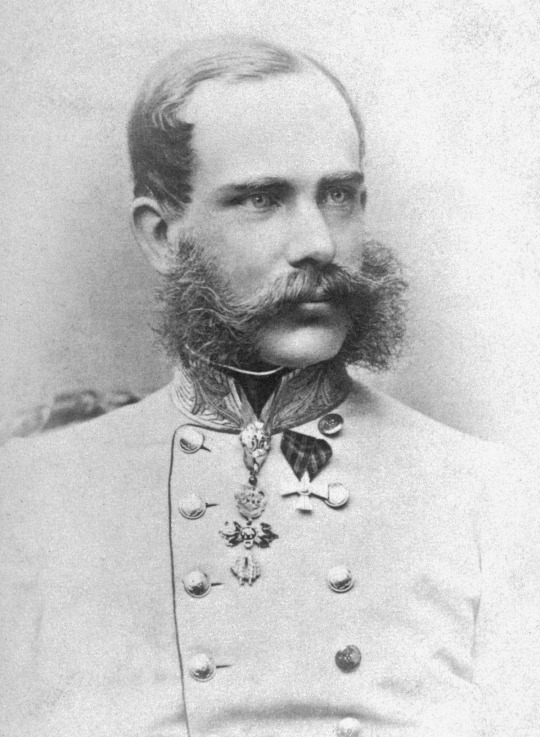

#19th century#compromise#european history#austria#hungary#Austrian Empire#austro-hungarian empire#austria-hungary#franz joseph#hapsburg#vienna#budapest
8 notes
·
View notes
Text
D.U.D.E Bios: Xanthia Winter
Geia's Middle Step-Daughter Xanthia WInter (2020)

The second daughter of Byron and step-daughter of Pelageya, Xanthia. She followed a 'freedom of mind' group out to North Carolina and hasn't spoken much to anyone since.
"Free your mind and join us."
Name
Full Legal Name: Xanthia Katherine Winter
First Name: Xanthia
Meaning: Modern elaborated form of 'Xanthe', Derived from Greek 'Xanthos' meaning 'Yellow, Blond, Fir-Haired'.
Pronunciation: KSAN-THEA
Origin: English
Middle Name: Katherine
Meaning: From the Greek name 'Aikaterine'.
Pronunciation: KATH-rin
Origin: English
Surname: Winter
Meaning: From Old English 'Winter’ or Old High German 'Wintar’ meaning 'Winter’.
Pronunciation: WIN-tar
Origin: English, German, Swedish
Alias: None
Reason: N/A
Nicknames: Kat, Kate, Kathy, Katie, Kitty, Thea, Xan
Characteristics
Age: 24
Gender: Female. She/Her Pronouns
Race: Human
Nationality: American
Ethnicity: White
Birth Date: November 29th 1996
Symbols: None
Sexuality: Sraight
Religion: Christian
Native Language: English
Spoken Languages: English, Spanish, Russian
Relationship Status: Dating
Astrological Sign: Sagittarius
Theme Song (Ringtone on Geia's Phone): 'Car Radio' - Twenty One Pilots'
Voice Actor: Sarah Silverman
Geographical Characteristics
Birthplace: Spokane, Washington, USA
Current Location: Asheville, North Carolina
Hometown: Asheville, North Carolina
Appearance
Height: 5'5" / 165 cm
Weight: 145 lbs / 65 kg
Eye Colour: Blue
Hair Colour: Brown
Hair Dye: None
Body Hair: N/A
Facial Hair: N/A
Tattoos: (As of Jan 2020) None
Piercings: Ear Lobe (Both)
Scars: None
Health and Fitness
Allergies: None
Alcoholic, Smoker, Drug User: Clean
Illnesses/Disorders: None
Medications: None
Any Specific Diet: None
Relationships
Allies: N/A
Enemies: N/A
Friends: Yasmine Lum, Natividad Marino, Honey Di Napoli, Seren Mathieson, Queen MacEntire, Ida Scott
Colleagues: N/A
Rivals: None
Closest Confidant: Kelvin Alden
Mentor: Byron Winter
Significant Other: Kelvin Alden (25, Boyfriend)
Previous Partners: None of Note
Parents: Byron Winter (53, Father), Caprice Winter (R.I.P, Mother, Née Thorne), Pelageya Winter (33, Step-Mother, Née Volkov)
Parents-In-Law: None
Siblings: Nathan WInter (33, Brother), Zinnia Turner (30, Sister, Née Winter), Xanthia Winter (24, Sister), Joseph Winter (21, Brother), Venetia Winter (18, Sister), Isaiah Winter (15, Brother), Uliana Winter (12, Half-Sister), Emil Winter (9, Half-Brother)
Siblings-In-Law: Genesis Winter (34, Nathan’s Wife, Née Rivers), Patrick Turner (31, Zinnia’s Husband)
Nieces & Nephews: Quincy Winter (13, Nephew), Hadley Winter (10, Niece), Bethany Turner (10, Niece)
Children: None
Children-In-Law: None
Grandkids: None
Great Grandkids: None
Wrestling
Billed From: N/A
Trainer: N/A
Managers: N/A
Wrestlers Managed: N/A
Debut: N/A
Debut Match: N/A
Retired: N/A
Retirement Match: N/A
Wrestling Style: N/A
Stables: N/A
Teams: N/A
Regular Moves: N/A
Finishers: N/A
Refers To Fans As: N/A
Extras
Trivia: Noting of Note
2 notes
·
View notes
Text
Day 8 of 30 Days of Hera
Variations on this deity (aspects, regional forms, etc.)
She is obviously compared with the Roman goddess Juno, who some believe is the same goddess, but she is also compared to Isis of the Egyptian pantheon.

She has cults in:
CULT IN BOEOTIA (CENTRAL GREECE)- PLATAEA (PLATAIA) Town in Boeotia (Boiotia) II. CORONEIA (KORONEIA) Village in Boeotia III. LEBADEIA Village in Boeotia
CULT IN OPUNTIAN LOCRIS (CENTRAL GREECE) - PHARYGAE (PHARYGAI) Village in Opuntian Locris (Lokris)
CULT IN SAMOS (GREEK AEGEAN) - SAMOS Main Town of Samos
LYDIA (ASIA MINOR) - SARDIS (SARDEIS) Main City of Lydia
CULT IN EGYPT (NORTH AFRICA - I. ALEXANDRIA Main City of Ptolemaic Egypt (Greek Colony) II. NAUCRATIS (NAUKRATIS) Town in Egypt (Greek Colony)
CULT IN SICILY (SOUTHERN ITALY) - HIMERA Town in Sicily (Sikelia) (Greek Colony)
CULT IN BRUTTIUM (SOUTHERN ITALY) - Near CROTON (KROTON) Town in Bruttium (Greek Colony)
CULT IN LUCANIA (SOUTHERN ITALY) - SYBARIS Town in Lucania (Greek Colony)Aelian, Historical Miscellany 3. 43 (trans. Wilson)
CULT IN PICENUM (SOUTHERN ITALY) - I. SILARIS R. River in Picenum & Lucania II. CUPRA (KYPRA) Town in Picenum (Greek Colony)
CULT IN VENETIA (NORTHERN ITALY) - HENETI (HENETOI) Tribe of Venetia
CULT OF JUNO IN LATIUM (CENTRAL ITALY) - LAVINIUM Town near Rome in Latium
CULT IN IBERIA (SOUTHERN SPAIN) - UNNAMED Islands near Gibralta in Iberia
This means there will be regional differences in how she is worshipped in these places just because the people there would have offered different sacrifices to the gods based on their society/ culture.
Egypt would worship the gods differently to Greece or Italy.
#30 days of deity devotion#30 days of devotion#30 days of hera#dodekatheism#hellenic polytheism#hellenismos#hellenic pagan#for the love of apollo#for the love of the dodekatheon#ares is great#Hail King Zeus and Queen Hera#hermes is my god#Hades is great too#Hestia is a sweetheart
10 notes
·
View notes
Photo





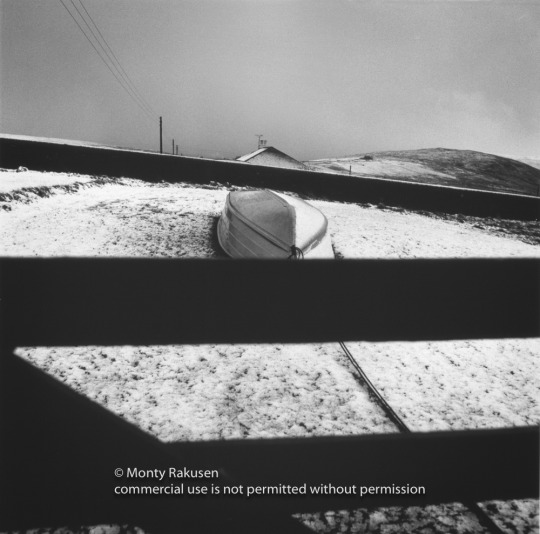




Voices in the Wind, the Northern Isles of Shetland Part 3
I awoke one morning in someone else’s flat and I couldn’t remember how I got there. My friend, fellow art student, Ceri Herington Pritchard https://ceripritchard.com/ decided we should go on an adventure.
"Let's go north" I said, and we did. We decided on Shetland, as it was as far north as we could think of going in the UK. It was October and cold, wintery, and Ceri let all the camping gas escape in Aberdeen before we had even got on the ferry. We didn’t have outdoor clothes like we have today. Ceri had a greatcoat and I had a tank driver's jacket, probably from the Korean war, that I’d stolen from the Combined Cadet Force at school.
When we arrived in Lerwick we headed north striding out as fast as we could. They were building the Sullom Voe oil terminal and the flat barren wind-swept landscape was dotted with ex red London double decker buses ferrying workers to the construction site, the destination windows read, Moorgate, Archway, Liverpool Street Station and so forth. We walked in a huge cavernous world of clouds coming from Greenland rising in the west and falling in the east with the sun shining through, highlighting the ceiling of our world and at sunset looked like God had appeared. I fell in a bog then it rained and there was freezing fog then I fell in a bog again.
On the 5th of November we were probably two of Europe’s most northerly campers, at the most northerly point of Shetland, a place where giants fought over the love of a mermaid, near the remote island of Muckle Flugga. https://en.wikipedia.org/wiki/Muckle_Flugga
Miserable, with teeth chattering and wet feet, I wore all the clothes I possessed and had to get up at 3am to crack the ice off my tent. On another night because of a storm we slept in a cement store hut and upon waking covered in dust looked like ghosts. One night, camped on a windy beach we were kept awake by boulders rolling in the surf. It was always spine chillingly cold and was only relieved by whisky in friendly pubs that felt like someones front room and there was usually a fidler. These experiences only gave me a love for this beautiful and remote place in the middle of the North Sea.
Nowhere is more than a mile from the sea on Northern Shetland and it is almost tree-less. Small crofts are dotted here and there with flapping, coloured, washing drying on lines, fishing boats far out at sea and the smell of burning peat on the wind. In those days the place was littered with abandoned rusting vehicles and the sides of the roads were covered in empty beer cans with the smiling face of Venetia Stevenson looking up at us https://www.cannyscot.com/SweetheartStout.htm, people built walls from un-returnable beer barrels and crofts lay derelict. Later, I believe, a vicar ordered a ship to take all the scrap away. No matter what the weather there was always some hardy soul out in the landscape, a small moving dot in the distance digging the peat, driving the sheep, rowing a boat. If you listened carefully there were voices on the wind.
I loved this wonderful strange place and began to plan a photo documentary. I first returned and shot it in 35mm colour transparency with the hope of printing it up in Ciba Chrome of which I was a big fan. Unfortunately the processing lab put a scratch through every roll of film and in those days it was impossible to retouch.
Each year I would return, shooting medium format black and white first with Hasselblad and then later Rollie 6006/8 and I gradually built up a collection of images searching for the essence of the place. I became friends with people there, the local doctor from Mid Yell and some people who looked after otters. They recognised me in the pubs.
Some years I walked the islands, some years I took my blue Landrover with its home made stereo and two cassettes that I bought in Aberdeen, The Smiths, Meat is Murder and Elvis Costello, Almost Blue. I drove around in the simmer dim the grey evening light, eventually knowing both albums by heart. The RAF invited me to their mid-summer beach party, it never got dark and in the morning I was dive bombed by bonxsies, mad sea birds, as I staggered around the landscape looking for fresh water. I fell in a bog again.
I was befriended by people who fed me boiled ham and potatoes, plied me with drink and had me shoot shotguns at empty cans thrown in the air. “Just mind the sheep, lad”. Coming out of the most northerly pub at half past eleven at night with the sun still shining in my eyes I stepped onto a Norwegian Trawler and got caught up in a fight. We sat in the mess as they fought round and round on the tables and each time they came past we clutched our drinks to our chests.
The photography project ran out of steam, my life had changed, I was busy at work, until Lizzie encouraged me to finish it and we travelled back there together to see Up Helly Aa, the ceremonial burning of the Viking longship https://www.uphellyaa.org/ and to show my work in progress to Shetland Arts with a view to exhibiting it. We stayed in Mid Yell in the snow with 125mph winds full of ice. Huge squalls blew in from the ocean flying low, dropping ice into the waves. When we were in Lerwick we were guests of the head of the Jarl squad, the viking leader of Up Helly Aa, a tremendous honour.
In the early morning, whilst he slept, we secretly tried on his Viking gear. I always felt welcome there and people were kind. An exhibition was arranged in Lerwick, British Airways helped me fly it up and then it travelled all over Scotland. I was interviewed by a lovely lady with small round John Lennon Spectacles from Radio Shetland, only problem was I could hardly understand a word she said. The exhibition opening was very well attended from islands far and wide, made more impressive by the fact no one could get back home to their islands until the ferries restarted in the morning. I felt proud when they said I had shown their home to them in a different way.
Text edit: John Coombes Encouragement: Liz Rakusen
1 note
·
View note
Text
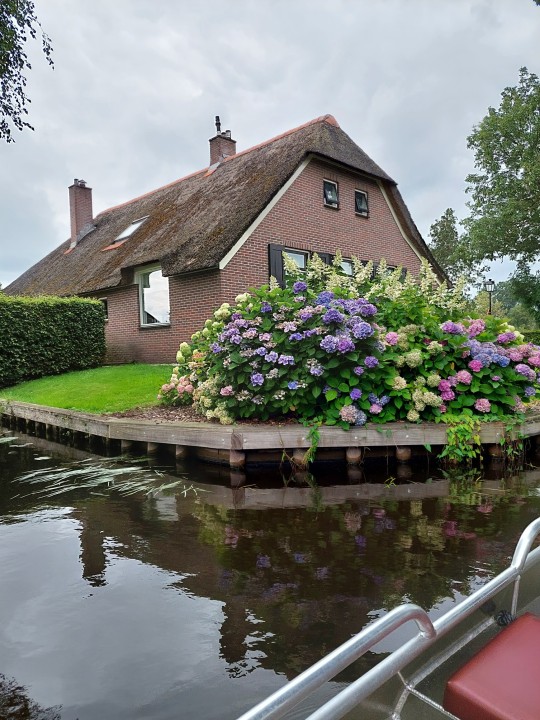
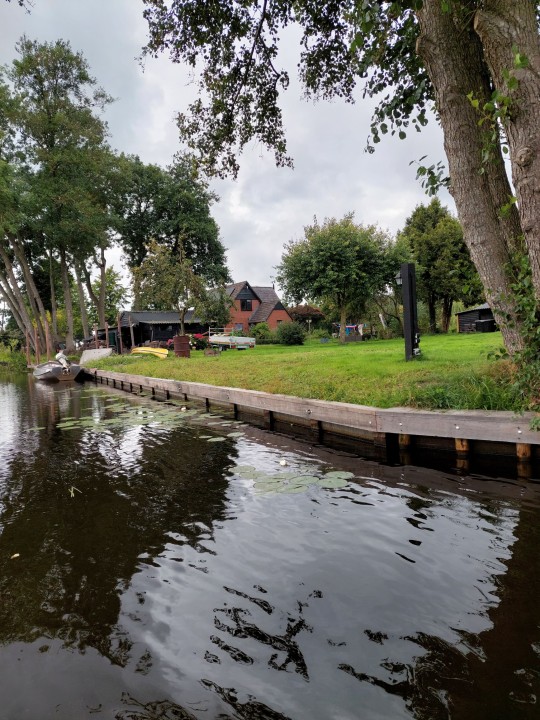

#giethoorn#overijssel#nederland#nederlands landschap#water#canal#lake#lakes#netherlands#dutch#dutch landscape#holland#hollande#mine#my pictures#my picture#photography#amateur photography#venetia of the north#venetie van het noorden#dutch architecture#architecture#hortensia#hydrangea#flowers#flat
2 notes
·
View notes